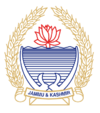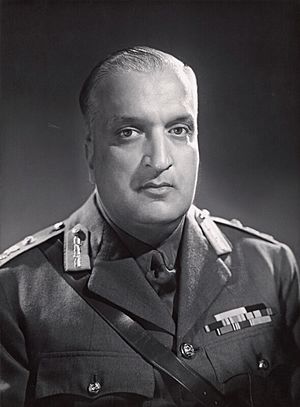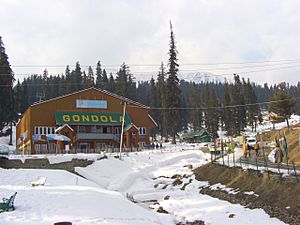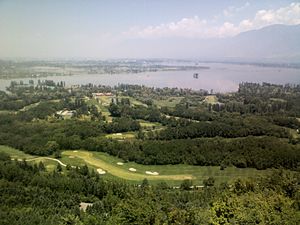Jammu and Kashmir facts for kids
Quick facts for kids
Jammu and Kashmir
|
|||
|---|---|---|---|
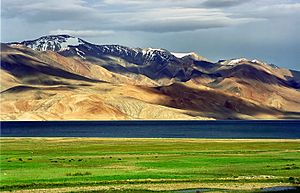
|
|||
|
|||
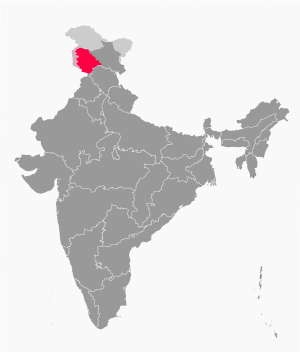
Location of Jammu and Kashmir in India
|
|||

Map of Jammu and Kashmir
|
|||
| Country | |||
| Admission to Union | 26 October 1947 | ||
| Capital | Srinagar (Summer) Jammu (Winter) |
||
| Districts | 22 | ||
| Area rank | 5th | ||
| Population
(2011)
|
|||
| • Total | 12,541,302 | ||
| • Rank | 19th | ||
| • Density | 56/km2 (150/sq mi) | ||
Jammu and Kashmir is a state in northern India. It is often called J&K for short. This state is mostly found in the Himalayan mountains. It shares its borders with the states of Himachal Pradesh and Punjab to the south.
Jammu and Kashmir was once part of a larger area called the Princely State of Kashmir and Jammu. Today, parts of this region are controlled by different countries. Some western areas are controlled by Pakistan, and an eastern region called Aksai Chin is controlled by China.
The state of Jammu and Kashmir has three main parts: Jammu, the Kashmir Valley, and Ladakh. Srinagar is the capital during summer, and Jammu is the capital in winter. Jammu and Kashmir is the only state in India where most people are Muslim. The Kashmir valley is famous for its stunning mountains. Jammu is known for its many shrines, which attract thousands of Hindu visitors. Ladakh is loved for its remote mountain beauty and Buddhist culture.
Contents
History of Jammu and Kashmir
Maharaja Hari Singh became the ruler of the Princely State of Jammu and Kashmir in 1925. He was the ruler when British rule in India ended in 1947. When India became independent, the British said that princely states like Kashmir could choose to join India, Pakistan, or stay independent.
Many people in both Pakistan and India hoped Kashmir would join their country. Maharaja Hari Singh was unsure what to do. On October 22, 1947, people from Pakistan invaded the state. The Maharaja fought back but asked India for help. India agreed to help, but only if Kashmir officially joined India.
On October 26, 1947, Maharaja Hari Singh signed a document called the Instrument of Accession. This meant Kashmir became part of India. Indian soldiers then entered Kashmir to stop the invaders. This led to the Indo-Pakistani War of 1947, which ended in late 1948. In 1948, India took the issue to the United Nations. A ceasefire was agreed upon in 1949, watched over by UN observers.
India and Pakistan fought two more wars in 1965 and 1971. After the last war, they agreed on a Line of Control (LoC). This line divides the areas they control. They also agreed to try and solve their disagreements peacefully through talks.
Exploring Tourism in Jammu and Kashmir
Before 1989, tourism was a very important part of Kashmir's economy. The Kashmir valley's tourism was hit hard by conflicts. However, the holy shrines in Jammu and the Buddhist monasteries in Ladakh remained popular places for visitors. Every year, thousands of Hindu pilgrims visit the holy shrines of Vaishno Devi and Amarnath. This helps the state's economy a lot.
Many areas in the Jammu region also have great potential for tourism. The Bhau Fort in Jammu city is a major attraction. The local aquarium is also visited by many people. About 10 million pilgrims visit Mata Vaishno Devi each year. This holy place is in the Trikuta Hills, about 40-45 km from Jammu City.
Tourism in the Kashmir valley has improved in recent years. In 2009, it became one of India's top tourist spots. Gulmarg is a very popular ski resort in India. It also has the world's highest green golf course. Less violence in the state has helped boost its economy and tourism. In 2011, over a million tourists visited Kashmir.
Culture and Traditions
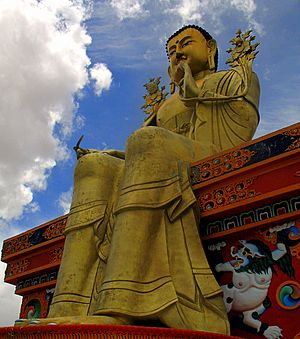
Ladakh is famous for its special Indo-Tibetan culture. Chanting in Sanskrit and Tibetan is a key part of the Buddhist way of life in Ladakh. Masked dance festivals, weaving, and archery are important traditional activities. Ladakhi food is similar to Tibetan food. Popular dishes include thukpa, which is noodle soup, and tsampa, a roasted barley flour. During festivals, people wear beautiful gold and silver jewelry and turquoise headgear.
The Dumhal is a famous dance in the Kashmir Valley. It is performed by men from the Wattal region. Women perform the Rouff, another traditional folk dance. Kashmir has been known for its fine arts, like poetry and handicrafts, for hundreds of years. Shikaras, which are traditional small wooden boats, and houseboats are common sights on the lakes and rivers in the Valley.
The Constitution of India used to have a rule. It did not allow people from outside Jammu and Kashmir to buy land in the state. Because of this, houseboats became popular for those who could not buy land. Now, houseboats are a big part of the Kashmiri lifestyle.
Kawa is a traditional green tea with spices and almonds. People drink it all day long during the cold winter in Kashmir. Most buildings in the Valley and Ladakh are made from softwood. Their design is influenced by Indian, Tibetan, and Islamic architecture.
Sports in Jammu and Kashmir
Srinagar has a golf course called Royal Springs Golf Course, Srinagar. It is located next to Dal Lake. Many people consider it one of the best golf courses in India.
The Ladakh Marathon takes place in Leh. It is recognized by the Association of International Marathons and Distance Races. This marathon is held at a height of 11,500 feet, making it the highest marathon in the world. In 2015, the Ladakh Marathon was even named one of the "top ten nicest marathons" globally.
Images for kids
-
A mosque in Srinagar
-
Gujjar man from Jammu & Kashmir
-
Tourism forms an integral part of the state's economy. Shown here is the Shalimar Gardens. Mughal emperor Jahangir inscribed Amir Khusrau's famous paradise on Earth verse in the gardens
-
Lake Tso Moriri
See also
 In Spanish: Jammu y Cachemira para niños
In Spanish: Jammu y Cachemira para niños



